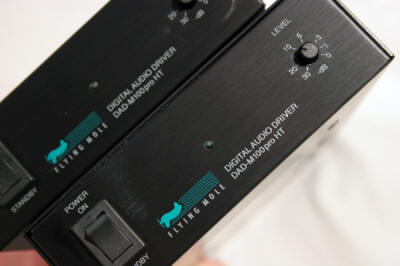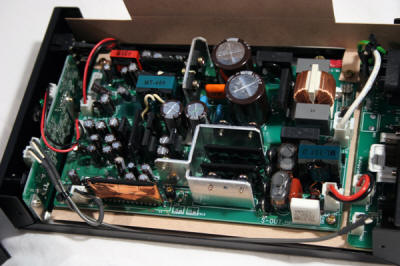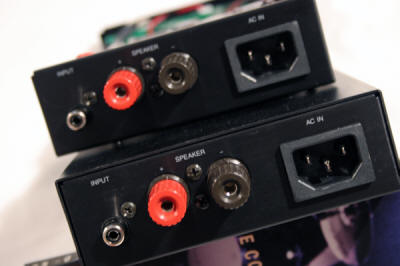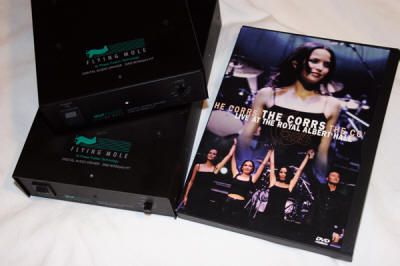You are reading the older HTML site
Positive Feedback ISSUE
17
january/february 2005
flying mole
DAD-M100 amplifiers
as reviewed by Ed Morawski

|
ED MORAWSKI'S SYSTEM: LOUDSPEAKERS ELECTRONICS SOURCE CABLES ACCESSORIES
|
When PFO editor Dave Clark sent an email to see if anyone was interested in reviewing the Flying Mole digital amplifiers, I agreed for two reasons: First, I am interested in digital technology, and feel that someday there will be a totally digital music reproduction system, and second, any company calling themselves Flying Mole had better have something good to offer! As it turns out, Flying Mole (www.flyingmoleelectronics.com) is a Japanese company specializing in home theater products that they proclaim to be of audiophile quality. While statements like this are usually dubious, in this case I found them accurate.
I was surprised by the weight of the carton in which the DAD-M100 monoblocks arrived—it was so light that I assumed only one amplifier was inside. In fact there were two, each weighing just 1 pound 7 ounces. They are also small, but check out the specs: 100 watts at 8 ohms, with a frequency response of 5 to 50K hertz, a signal-to-noise ratio of 120 dB, distortion of .03% at 1K, 8 ohms, and 50 watts. These are impressive specs for any amplifier, let alone one that sells for $500. The box also contained a thick information packet detailing Yasumasa Sasahara's design concepts. The main ones are dual negative feedback from both the digital and analog output stages and Bi-Phase conversion of the pulse width modulation. Both concepts make sense from an engineering standpoint, and are not marketing hype. The product sheets also detailed the various configurations of the basic amplifier. There appears to be a model suited for every possible need, including multi-channel setups and a 12-volt DC model that could be used for car stereo.

The binding posts are two-way plastic. They are shrouded, which means you have to use either bare wire or banana plugs. They are spaced too wide for double bananas, so only singles will work (a problem for me, as I had nothing that fit). The RCA inputs are nothing to write home about either, but at this price point I suppose that is to be expected. Each unit has an IEC power connector, as well as a gain control on the front.

Could these diminutive boxes create audiophile sound? After disconnecting some speaker cables from my home theater and rearranging some things, I was able to get the M100s powered up. I ran my Musical Fidelity Nu Vista CD player directly into the M100s, and used their gain controls to adjust the volume. I was immediately struck by the deepness of the bass, which was simply astounding for such tiny units, but the rest of the frequency spectrum left me unimpressed, though in all fairness this was with cheap speaker cables, cheap interconnects, and the OEM power cords.
I then installed the M100s in my home theater system and left them there for several weeks. They performed adequately, and I soon forgot about them. I had more time to listen over the holidays, so I moved the M100s into my music room. I modified a set of Empirical Audio speaker cables with banana adapters, and using Empirical Holographic interconnects and Shunyata Research Diamondback power cords, I tried the Flying Mole units one more time. This time, I fed the Musical Fidelity Nu Vista into my E.A.R. 864 tube preamp, and the M100s drove a pair of Von Schweikert VR-1 monitor speakers. I was now awestruck by the Flying Moles! I attributed the vastly improved sound to several factors. Apparently they were now broken in, plus I was using a preamp. I have never liked any component fed directly into a power amp, and the Flying Moles were no exception. The E.A.R. 864 did wonders for the dynamics, which were now anything but lifeless.
Diana Krall's Live in Paris was the first CD I played, and it didn't leave the player for its entire 65 minutes. I very rarely listen to an entire album when reviewing equipment, but the time passed so pleasantly that when the room went silent at the end of the CD, I was caught off-guard. I had been completely drawn into the music and the M100s' portrayal of a live performance. There was no hint of harshness, grunge, brightness, or digital artifact. Smooth sounds enveloped my room. Diana's voice was sweet and clear. The soundstage was generously wide, and every member of the band stood in perfect position (as I knew from watching the DVD). I was especially pleased with the piano and drums, but Anthony Hamilton's guitar and John Clayton' bass had never sounded better. I took special note of Hamilton's guitar, as I have heard it sound hot and screechy on some systems. The M100s' detail and resolution were astonishing.

Patricia Barber's Café Blue went in next, as a real test of these little amps. The brushes and cymbals on "The Thrill is Gone" sounded just right, like textured sounds instead of white noise. On "Ode to Billy Joe," I was impressed by the bass, and especially by the finger snapping, which stood out in three-dimensional relief. Again I listened all the way through the CD without realizing. I frankly didn't want it to end. The M100s are a music lover's joy.
During the following weeks I tried many different equipment combinations with the Flying Moles. Power cords made a big difference, and it turned out that the Shunyata Diamondbacks sounded best by a wide margin. The same went for the E.A.R. preamp. I tried feeding the M100s directly into the amps again, but didn't care for that at all. The real eye openers were the speakers. In addition to the Von Schweikerts, I used Usher X719s and my home-built units with Scan Speak 8535 and 9500 drivers. Each time, the sound took on the quality of the speakers, not the amps. The amps got completely out of the way.
Do I have any gripes about the M100s? Sure. First, they are so light that I had a tough time keeping them in place. My speaker cables were much heavier than the amps! Even my interconnects tended to push the amps aside or completely off the shelf, and forget about my power cords! I ended up placing a marble slab on top of each amp, just to keep them in place. Those binding posts have to go as well. Despite these quibbles, the Flying Mole M100s had me thinking about a killer budget system. Let's see, the M100s in 12VDC form, the Von Schweikert VR-1s, and maybe a Njoe Tjoeb CD player? I get goose bumps just thinking about it. For less than $3000, you could have a system rivaling anything on the market, at any price. Ed Morawski
DAD M100 amplifiers
Retail: $699/pair
Flying Mole
web address:
www.flyingmole.co.jp
